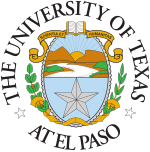Texas Western University
 |
|
| Motto | Scientia et Humanitas |
|---|---|
|
Motto in English
|
Science and Humanities |
| Type | Public, Hispanic-serving institution |
| Established | 1914 |
|
Academic affiliations
|
UT System APLU |
| Endowment | $217.28 million |
| President | Diana Natalicio |
|
Academic staff
|
1,309 (Fall 2012) |
|
Administrative staff
|
1,511 |
| Students | 23,397 |
| Undergraduates | 20,220 |
| Postgraduates | 3,177 |
| Location | El Paso, Texas, U.S. |
| Campus | Urban, 366 acres (1.48 km2) |
| Colors | Dark Blue, Orange, and Silver Accent |
| Nickname | Miners & Lady Miners |
|
Sporting affiliations
|
NCAA Division I FBS – C-USA |
| Mascot | Paydirt Pete |
| Website | www |
 |
|
| University rankings | |
|---|---|
| National | |
| Forbes | 608 |
| Washington Monthly | 93 |
Coordinates: 31°46′12″N 106°30′18″W / 31.77000°N 106.50500°W
The University of Texas at El Paso (UTEP) is a public research university in El Paso, Texas, United States. The school was founded in 1914 as the State School of Mines and Metallurgy, and a practice mineshaft survives on the mountainous desert campus. Following a reorganization of the University of Texas in 1920, the school was renamed the College of Mines and Metallurgy of the University of Texas. It became Texas Western College of the University of Texas in 1949, and The University of Texas at El Paso in 1967. UTEP is part of the University of Texas System.
UTEP is the second-largest university in the U.S. to have a majority Mexican American student population (about 80%). The campus features a collection of buildings in the Dzong architectural style. It is on hillsides overlooking the Rio Grande, with Ciudad Juárez in view across the Mexico-United States border.
On April 16, 1913, SB 183 was signed by the Texas governor allocating funding for a new institution, making it the second oldest academic institution in the University of Texas system. The school officially opened on September 28, 1914, with 27 students in buildings belonging to the former El Paso Military Institute on a site just adjacent to Fort Bliss on the Lenoria Mesa. By 1916, enrollment had grown to 39 students, including its first two female students, Ruth Brown and Grace Odell. On October 29, 1916, a devastating fire destroyed the main building of the school, prompting its relocation. In 1917, the new school facility was constructed on its present site above Mundy Heights, with the land donated by several El Paso residents. In a period when United States architects were designing in styles adopted especially from Europe, Kathleen Worrell, wife of the university's dean, was attracted by photographs of the Kingdom of Bhutan in a 1914 issue of National Geographic magazine, which showed the dzong architecture style of its Buddhist monasteries. The resemblances between the local terrain and mountainous features of Bhutan inspired her to propose designing early buildings of the mining school in the dzong style. Liking its distinctiveness, administrations have continued to choose that style for additional facilities, including the Sun Bowl football stadium and parking garages. Dzong (fortified religious and administrative centers) has characteristics such as sloping sides, markedly overhanging roofs, and bands of colored decoration.
...
Wikipedia
